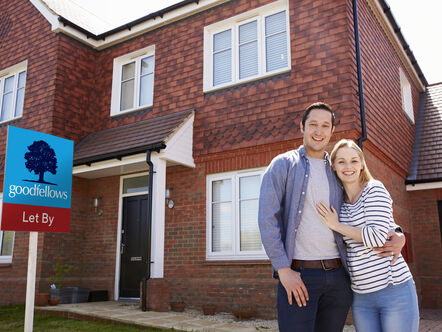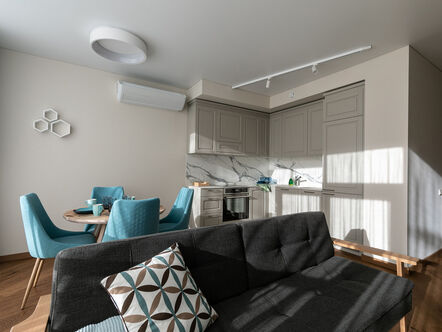Buy-to-Let is an investment where a property is purchased, usually with a mortgage, with the intention of letting it out to a third party.
It remains an excellent long term investment, although, like all investments, there are risks attached to buy-to-let. Recent governments have introduced higher Stamp Duty taxes and have reduced the tax relief that landlords can claim. However, despite its ups and downs, the residential property market has one of the most stable growth patterns as an investment class in the long-term.
There are different reasons for investing in buy-to-let and understanding what you are trying to achieve is key to where and what you buy. Are you looking for long-term capital appreciation (the value of your property going up), or a regular source of income from the rent?
If you are looking to invest, considering a buy-to-let property could be very rewarding and is something Goodfellows can help you get the most out of. Our local lettings experts can help find a suitable investment that suits you and can support you through every stage of buying and managing your property.
What sort of property should I buy and in which area?
Finding the right property in the right location is important when searching for your own home. But it's equally important when looking for a buy-to-let property.
The type of tenant you are targeting will influence the type and location of the property buy. Students are likely to want to live in an affordable property close to their university and nightlife, young professionals might want good transport links for an easy commute, while families will be interested in the proximity of good schools, plenty of storage space and a garden. Getting the location and type of property right will help you achieve higher rents and find tenants more easily.
Some investors prefer to buy houses, whilst others favour apartments. There are advantages and disadvantages to both and ultimately it is down to personal preference. It’s worth considering that some properties may be more difficult to secure a mortgage on, such as former council houses, new developments and flats above commercial premises or shops.
Research the potential rental income of each property and look at the “fundamentals”; how close the property is to shops, transport links, schools and any other amenities you think would be important to tenants.
By becoming a landlord you are essentially running a business, so it is important to buy with your head, not your heart. Choose a property that is in demand in the area and not necessarily one that you would want to live in yourself. This property is not going to be one that needs to reflect you and your tastes, so be practical.
If you are just starting out in buy-to-let, buying a property close to home could be a good bet. As well as being familiar with the area, you'll be on hand should anything go wrong. However, using an ARLA registered letting agent like Goodfellows to manage the property can present a wider range of options further afield. When you know which area you want to invest in, speak to local letting agents who can advise on what kind of properties are in demand and how much they rent for.
Considerations & Risks
Managing a buy-to-let property can come with a lot of work, commitment and planning in order to be successful. An empty property or a tenant not paying their rent can impact the return on your investment as any mortgage repayments have to be paid by you, regardless of whether there is rent coming in.
Property investment is a medium to long-term investment and growth in the long term is generally good. However, changes in the market, interest rate changes and vacant periods mean that, even if you have a professional property management company like Goodfellows looking after the day-to-day running of your property, it is always recommended to make sure you have some level of contingency funds in a dedicated bank account to cover any surprise costs.
When finding tenants for your property, a good lettings agent will require a credit check, previous landlord references, work references and affordability acceptance, all of which will help reduce the risks of non-payment of rent or damage being caused to your property.
Our partners LegalforLandlords can also offer rent-protection insurance to protect you from these risks.
Buy-to-Let mortgages
Most buy-to-let properties are purchased with a mortgage. There are a number of differences between a residential and buy-to-let mortgage, including the way your affordability is calculated.
Instead of your salary, the lender will consider the expected rental income of the property as your primary income source. Some lenders will then take your personal income into account as a secondary factor.
Lenders will usually want the rental income to meet a stress test to reassures them that you will be able to meet your mortgage commitment. The rent charged must be at least 125% of the monthly interest payments on the loan for basic rate tax payers, and from 2017, at least 145% for higher rate tax payers. The interest used in the rental cover calculation should be at least 5.5%, according to PRA rules, even if the rate on the actual mortgage deal is lower than this.
The deposit on a buy-to-let mortgage also tends to be bigger than the one required for a residential one. Most buy-to-let deals required 25% deposit, ranging as high as 40% or more for the very cheapest deals.
If you previously lived in the property and you have a residential mortgage on it, you must always get your lender’s permission to rent it out. If you are buying another property to live in, you may be able to convert your existing product into a Let-to-Buy mortgage.
When you buy your property and rent it out you will have cover the usual costs of buying, including: Stamp Duty, Solicitor’s fees, Survey fees, Agents Letting & Management Fees. If you later decide to sell the property you will have legal costs and further agency fees to pay for finding a buyer.
Whether you choose to let your property with Goodfellows or not, our partners Embrace Financial Services can offer professional expertise on a buy-to-let mortgage.
What are my responsibilities as a landlord?
Being a landlord comes with legal responsibilities. Your tenants must be assured that their right to live in your property is protected by a tenancy contract and that their deposit is in safe hands.
Day-to-day repairs and upkeep of the property is the responsibility of the landlord, so potential costs should be factored into your plan.
Other landlord responsibilities include:
- Making the property safe for tenants to live in
- Maintaining heating and water systems
- Making sure furniture meets fire safety regulations
- Ensuring that the gas and electrics are safe
- Providing tenants with certain paperwork
You can read more about the responsibilities of a landlord in our Landlord compliance guide.
Landlord Insurance
It is usually a requirement of mortgage lenders that you have buildings insurance in place. This will pay out in the event your property is damaged or destroyed and needs to be repaired or rebuilt.
Specialist Landlord Insurance products are available which may also include public liability insurance if a tenant gets hurt, protection of fittings and fixtures such as carpets, curtains and white goods, and even things like hotel accommodation in the event the property becomes uninhabitable.
Our partners First2Protect can offer a range of insurance products to suit your needs.
Tenants should also take out their own contents insurance as items belonging to them will not be covered under the landlord’s insurance.
Tax Responsibilities
Stamp Duty Land Tax
This tax is payable on both freehold and leasehold properties purchased outright or with a mortgage.
Use our stamp duty calculator below to get an indication of how much this could be.
Income Tax
Income tax is payable on rental income but buy-to-let landlords can offset certain ‘allowable expenses’ to reduce their tax liability.
These can include:
- Buildings and contents insurance.
- Rent, ground rent, service charges.
- Professional fees – Accountants, Letting agents and some Legal fees
- Maintenance and repairs to the property (but not improvements).
- Council Tax & Utility bills - gas, water and electricity (if included in the rent).
- Additional services provided for tenants, like cleaning or gardening.
- Phone calls, stationery and advertising related to letting the property.
From April 2020, landlords are no longer able to deduct mortgage expenses from rental income to reduce their income tax bill. Instead, you will receive a tax-credit at a rate of 20% of mortgage interest payments.
Costs relating to buying a property or renovating it beyond repairs for wear and tear are considered “capital expenditure” and are not included in allowable expenses
You must report income from property rental if it is:
- £2,500 to £9,999 after allowable expenses
- £10,000 or more before allowable expenses
It is recommended to consult a qualified tax account.
National Insurance
If all of the following apply you’ll also have to pay Class 2 National Insurance contributions as what you do counts as running a property business:
- Being a landlord is your main job.
- You rent out more than one property.
- You’re buying new properties to rent out.
You don’t have to pay National Insurance on your rental income if you’re not running a property business - even if you do work like arranging repairs, advertising for tenants and arranging tenancy agreements.
Capital Gains Tax
If the value of your investment property has grown if/when you eventually sell it, you will be liable to pay Capital Gains Tax.
Find out more at: www.gov.uk/capital-gains-tax
Overseas Landlord Tax
If you are live or are going to be overseas for a period longer than 6 months you will be classed as and overseas landlord and as such liable for a 20% tax on your share of the rental income.
Find our more in our Overseas landlords guide.
Do I need to use an agent and how much will it cost?
The decision on whether to use a letting agent will depending on how involved you want to be with the property. At Goodfellows we are proud of the wealth of knowledge and experience we can offer you as a landlord. We offer different levels of services which you can select to meet your individual requirements.
We can guide you through every step of the process, whether you want our experienced lettings team to take care of the day-to-day management of your property so you don’t have to worry about it, or you’re a letting veteran and just want some help attracting tenants, we’re here to help with whatever your need.
Buy-to-Let with Goodfellows
We can help you with:
- Searching for your buy-to-let property
- Providing local expertise in the area’s letting market
- Expert knowledge of the area - shops, transport links, schools and other amenities
- Professional advice on your investment
- Advice on legal requirements, compliance and legislation
Find out more about our range of lettings services that can support your buy-to-let journey.



